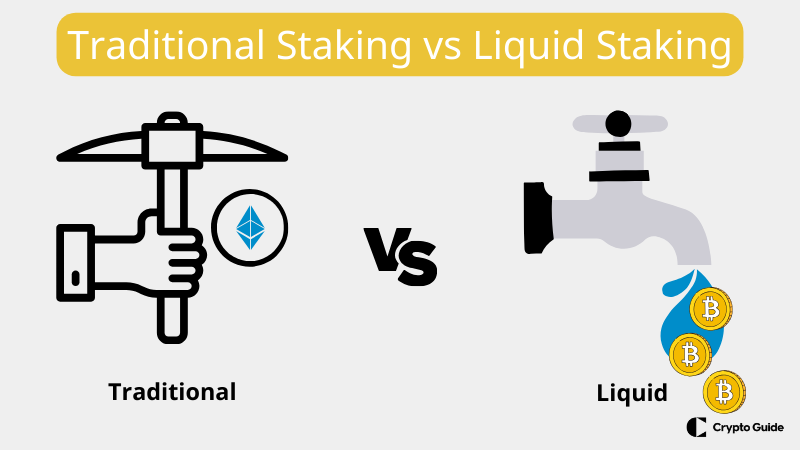What is Liquid Staking?
When you stake tokens, you can't use them for other things like trading or getting more earnings in DeFi. But some services let you stake your tokens and give you a different token in return. This new token shows you still own the staked ones, and you can trade it or use it on blockchain apps.
In this article we analyze this process in detail and answer how liquid staking works, its benefits and limitations, popular tokens, and much more.
Table of content
What is Staking?
Staking is like putting some of your cryptocurrency aside to help run a blockchain network; you get rewards for doing it.
It is like putting your money into a special online savings account. Locking your digital coins on the blockchain, a digital ledger, helps keep the network safe and running smoothly. In return for helping out, you get extra coins as a reward, similar to how you earn interest from a bank.
Staking is important for certain blockchains that use a system called Proof of Stake (PoS) or similar methods. Instead of using a lot of electricity to create new blocks like Proof of Work (PoW) does, PoS uses the coins that people hold to choose who gets to create new blocks and keep the blockchain running.
Assets that are locked up, or “staked,” encourage people who validate transactions to follow the rules. If they try to break the rules or do something bad, they could lose some of the money they put in. This setup helps keep the system safe and ensures that transactions are handled correctly.
What is Liquid Staking?
Liquid staking in crypto lets you make the most of your staked assets by allowing you to use them in the DeFi world.
Here's how it works:
Liquid staking in cryptocurrency enables users to stake their tokens to support network security and consensus while receiving a liquid, tradable token in return. This process maintains liquidity, allowing users to participate in other investments or activities without locking assets.
This innovation allows participants to engage with various decentralized finance applications, from loan platforms to betting markets, without the need for specialized equipment or technical know-how.
The process not only unlocks liquidity, enabling the use of staked assets across the DeFi ecosystem but also opens up a chance for additional earnings through participation in various DeFi services, on top of the rewards from staking itself.

Traditional Staking vs Liquid Staking
Staking crypto can earn rewards, but the two methods have different styles. Traditional staking tokens help the network directly, earning potentially higher rewards. Downside? Your tokens are locked until the staking period ends.
Liquid staking allows you to get tokens representing your staked assets, letting you trade them or use them in DeFi while still earning (slightly lower) rewards. So, you rely on a third party, adding some risk.
People choose traditional staking for higher rewards and direct participation or liquid staking for flexibility and DeFi access.
| Feature | Traditional Staking | Liquid Staking |
| Asset Locks | Assets are locked for a period (“locked up”) | Users receive liquid tokens representing their staked assets |
| Liquidity | Assets cannot be traded or used elsewhere | Liquid tokens can be traded or used in DeFi, and etc. |
| Rewards | Generally higher potential rewards due to the validator role | May have slightly lower rewards due to protocol fees |
| Composability | Limited access to DeFi opportunities while staked | Enables participation in various DeFi protocols with staked assets |
| Risks | Lower technical risk | Higher counterparty risk (relies on staking provider) |
| Decentralization | Users directly participate in network validation | More centralized, relies on staking provider |
| Examples | Cosmos, Polkadot, Cardano | Lido, Rocket Pool |
Advantages of Liquid Staking
You may wonder what are the advantages of liquid staking tokens, they offer several of them:
- Releasing Locked Funds: In Ethereum and similar networks, when you stake tokens, you can't trade them or use them as security for loans. But with liquid staking, you can still use the value of these tokens for trading or as security in DeFi apps even though they are staked.
- Enhancing DeFi Integration: When you stake digital assets, you can get special tokens as a receipt. These tokens can be used in different online financial services, such as borrowing money or betting on future events.
- Expanding Earning Potential: Traditional staking pays users for helping with transactions. Liquid staking lets users earn more by using different financial services.
- Simplifying Participation: Liquid staking services let people earn money from blockchain rewards easily, without needing to set up complicated systems or have a lot of ETH as solo validators do on the Ethereum network.
Risks and Limitations
Liquid staking also comes with risks and limitations. It's important to be aware of these before you decide to participate in liquid staking:
- Slashes: In a proof-of-stake network, if a validator you've picked does something bad or doesn't do their job right, they can be punished. If that happens, you could lose some of the money you put in with them. This is why it's important to pick trustworthy validators when you're staking your assets in a way that lets you still use them.
- Exploits: Platforms and protocols that allow for liquid staking can be attacked by hackers. This can cause people to lose their staked money or make the tokens they get for staking less valuable. It's very important to check how secure a liquid staking service is and see if it has a good history of safety before using it.
- Secondary Market Volatility: When you do liquid staking, you get special tokens that stand for the money you put in. You can buy and sell these tokens. But their price can change a lot because of how people feel about the market, how easy it is to buy and sell them, and how the crypto market is doing. This can affect how much your investment is worth, and it might not always match how well the actual assets are doing.
Liquid Staking Protocols
Liquid staking protocols like Lido and Rocket Pool are changing how people use staking in Ethereum by offering new ways to solve problems like not being able to use your staked funds and needing a lot of money to start staking. They make it easier and more accessible.
What Is Lido Staking?
Lido is a decentralized finance protocol that offers liquid staking for Ethereum, among other blockchains. When users stake their Ethereum (ETH) through Lido, they receive stETH (staked ETH) in return, which represents their staked ETH plus earned rewards.
This ETH can then be used across various DeFi protocols, enabling users to earn additional income from their staked assets.
Lido's main advantage is its ability to provide immediate liquidity to staked assets, making it an attractive option for investors who don't want to lock up their capital.
Rocket Pool Service
Rocket Pool is a popular service on the Ethereum network that lets people stake their cryptocurrency or run their computer servers for the network. By staking ETH with Rocket Pool, users receive rETH, a token that represents their staked ETH and accumulated staking rewards.
Rocket Pool distinguishes itself from a decentralized network of operators, ensuring a high degree of decentralization and security. It lowers the entry threshold for staking on Ethereum by allowing participation with as little as 0.01 ETH, making it accessible to a broader audience.

Popular Tokens That Support Liquid Staking
By participating in liquid staking, you receive liquid staking tokens (LSTs) that represent your staked assets and can be used for various DeFi purposes like lending or trading.
Here are some of the most popular tokens that support liquid staking:
Ethereum (ETH)
- Lido Staked Ether (stETH): The most popular LST, offering exposure to staked ETH and representing the largest market share.
- Rocket Pool ETH (rETH): A decentralized alternative to Lido, offering a community-driven approach to liquid staking ETH.
- Other options: Frax Ether (frxETH), Mantle Staked Ether (METH), etc.
Solana (SOL):
- Marinade Staked SOL (mSOL): A leading provider of liquid staking solutions for SOL, offering mSOL tokens representing staked SOL.
- Lido Staked SOL (stSOL): Lido's offering for liquid staking SOL, provides an alternative to Marinade.
Cosmos (ATOM)
- Stride Staked ATOM (stATOM): A popular solution for liquid staking ATOM, enabling participation in the Cosmos ecosystem.
- Other options: Liquid Staking (LQST), Agoric (AGT), etc.
Other tokens
- A variety of other tokens like Polygon (MATIC), Polkadot (DOT), Avalanche (AVAX), and Cardano (ADA) also have various liquid staking options available.
Liquid Staking Conclusion
Liquid staking lets people earn rewards by staking, without giving up control of their assets. This means you can still use crypto to make more money or borrow against it, making everything more flexible and accessible.
While it offers many benefits like easier access to DeFi and the potential for extra earnings, users should still watch out for risks like security issues or price changes.
In general, liquid staking is making staking simpler and more useful for everyone, boosting the power of DeFi along the way.
FAQ About Liquid Staking
How does liquid staking work?
Liquid staking lets you stake your crypto and receive a tradeable token in return. This token represents your staked assets and can be used in DeFi platforms.
What is the difference between liquid staking and staking?
Liquid staking provides a token representing your staked assets for use in DeFi, offering liquidity. Traditional staking locks your assets, restricting their use outside of earning staking rewards.
Is liquid staking risky?
Yes, it involves risks like security vulnerabilities of the staking platform, the potential for loss due to validator penalties (slashing), and price volatility of the issued tokens.
What tokens support liquid staking?
Popular tokens supporting liquid staking include Ethereum (ETH), Solana (SOL), and Cosmos (ATOM), with platforms issuing their versions of staked tokens (e.g., stETH for Ethereum).
What are the most popular liquid staking protocols?
Lido and Rocket Pool are among the most popular, offering liquid staking solutions for Ethereum and other cryptocurrencies.



